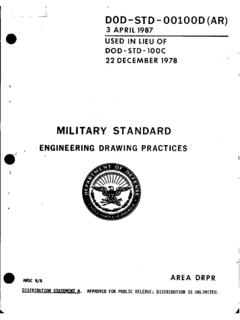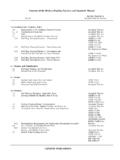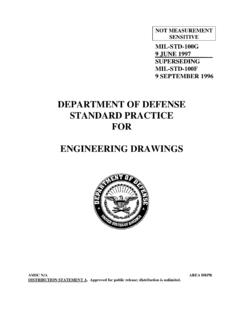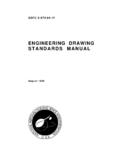Transcription of ENGINEERING WORKSHOP LAB MANUAL
1 ENGINEERING WORKSHOP . LAB MANUAL . ENGINEERING Work Shop Department of Mechanical ENGINEERING Page 2. ENGINEERING Work Shop Department of Mechanical ENGINEERING CONTENTS. Instructions for Laboratory .4. Experiment Page no. 1. BLACKSMITHY 6. 2. CARPENTRY 13. 3. FITTING 22. 4. FOUNDRY 31. 5. TINSMITHY 42. 6. WELDING 50. 7. HOUSEWIRING 61. 8. PUMBLING 69. 9. POWER TOOLS 74. Page 3. ENGINEERING Work Shop Department of Mechanical ENGINEERING Instructions for Laboratory The objective of the laboratory is learning. The experiments are designed to illustrate phenomena in different areas of WORKSHOP and to expose you to uses of instruments. Conduct the job with interest and an attitude of learning. You need to come well prepared for the job. Work quietly and carefully (the whole purpose of experimentation is to make reliable measurements!) and equally share the work with your partners. All presentations of job and diagram should be neatly and carefully done.
2 Diagrams should be neatly drawn with pencil. Always display units. Come equipped with scales, pencils etc. Do not fiddle idly with apparatus. Handle instruments with care. Report any breakage to the Instructor. Return all the equipment you have signed out for the purpose of your experiment. Page 4. ENGINEERING Work Shop Department of Mechanical ENGINEERING Syllabus B. V. RAJU INSTITUTE OF TECHNOLOGY (AUTONOMOUS), NARSAPUR, MEDAK (DIST). I Year B. Tech L T/P/D C. - - /3 / - 2. ENGINEERING WORKSHOP . (Common to all branches). Objective: To familiarise with the basic manufacturing processes and to study the various tools and equipment used, hands-on training is given in different sections. Essentially student should know the labour involved, machinery or equipment necessary, time required to fabricate and also should be able to estimate the cost of the product or job work. TRADES FOR EXERCISES: At least two exercises from each trade: a.
3 Carpentry: Middle lap T joint, cross lap joint, mortise and tenon T joint, Bridle T joint b. Fitting: Square joint, V joint, half round joint, dovetail joint c. Tin-Smithy: Tray, cylinder, hopper, funnel d. Black Smithy: Simple exercises based on black smithy operations such as upsetting, drawing down, punching, bending, swaging and fullering e. House-wiring: wiring for ceiling rose and two lamps (bulbs) with independent switch controls with or without looping, wiring for stair case lamp, wiring for a water pump with single phase starter. f. Foundry: single pattern, double pattern TRADES FOR DEMONSTRATION: a. Plumbing b. Machine Shop c. Welding d. Power tools in construction, wood working, electrical ENGINEERING and mechanical ENGINEERING . Outcomes Basic practice sessions must be conducted in the trades mentioned and then two products of Industrial application (with combination of different trades) may be produced with the available resources.
4 REFERENCE BOOKS: 1. ENGINEERING Work shop practice for JNTU, V. Ramesh Babu, VRB Publishers Pvt. Ltd. 2. Work shop MANUAL / SciTech Publishers. 3. ENGINEERING Practices Lab MANUAL , Jeyapoovan, SaravanaPandian, Vikas publishers 4. Dictionary of Mechanical ENGINEERING , GHF Nayler, Jaico Publishing House. Page 5. ENGINEERING Work Shop Department of Mechanical ENGINEERING BLACKSMITHY. Blacksmithy or Forging is an oldest shaping process used for the producing small articles for which accuracy in size is not so important. The parts are shaped by heating them in an open fire or hearth by the blacksmith and shaping them through applying compressive forces using hammer. Thus forging is defined as the plastic deformation of metals at elevated temperatures into a predetermined size or shape using compressive forces exerted through some means of hand hammers, small power hammers, die, press or upsetting machine. It consists essentially of changing or altering the shape and section of metal by hammering at a temperature of about 980 C, at which the metal is entirely plastic and can be easily deformed or shaped under pressure.
5 The shop in which the various forging operations are carried out is known as the smithy or smith's shop. Hand forging process is also known as black-smithy work which is commonly employed for production of small articles using hammers on heated jobs. It is a MANUAL controlled process even though some machinery such as power hammers can also be sometimes used. Black-smithy is, therefore, a process by which metal may be heated and shaped to its requirements by the use of blacksmith tools either by hand or power hammer. Forging by machine involves the use of forging dies and is generally employed for mass- production of accurate articles. In drop forging, closed impression dies are used and there is drastic flow of metal in the dies due to repeated blow or impact which compels the plastic metal to conform to the shape of the dies. Applications of forging Almost all metals and alloys can be forged. The low and medium carbon steels are readily hot forged without difficulty, but the high-carbon and alloy steels are more difficult to forge and require greater care.
6 Forging is generally carried out on carbon alloy steels, wrought iron, copper-base alloys, aluminum alloys, and magnesium alloys. Stainless steels, nickel-based super alloys, and titanium are forged especially for aerospace uses. FORGEABILITY. The ease with which forging is done is called forgeability. The forgeability of a material can also be defined as the capacity of a material to undergo deformation under compression without rupture. Forgeability increases with temperature up to a point at which a second phase, , from ferrite to austenite in steel, appears or if grain growth becomes excessive. COMMON HAND FORGING TOOLS. For carrying out forging operations manually, certain common hand forging tools are employed. These are also called blacksmith's tools, for a blacksmith is one who works on the forging of metals in their hot state. The main hand forging tools are as under. Tongs The tongs are generally used for holding work while doing a forging operation.
7 Various kinds of tongs are shown in Figure. a) Straight-lip fluted tongs are commonly used for holding square, circular and hexagonal bar stock. b) Rivet or ring tongs are widely used for holding bolts, rivets and other work of circular section. c) Flat tongs are used for mainly for holding work of rectangular section. d) Gad tongs are used for holding general pick-up work, either straight or tapered. Flatter Flatter is shown in Fig. It is commonly used in forging shop to give smoothness and accuracy to articles which have already been shaped by fullers and swages. Page 6. ENGINEERING Work Shop Department of Mechanical ENGINEERING Swage Swage is used for forging work which has to be reduced or finished to round, square or hexagonal form. It is made with half grooves of dimensions to suit the work being reduced. It consists of two parts, the top part having a handle and the bottom part having a square shank which fits in the hardie hole on the anvil face.
8 Fuller Fuller is used in forging shop for necking down a forgeable job. It is made in top and bottom tools as in the case of swages. Fuller is made in various shapes and sizes according to needs, the size denoting the width of the fuller edge Punch Punch is used in forging shop for making holes in metal part when it is at forging heat. Rivet header Rivet header (Fig. ) is used in forging shop for producing rivets heads on parts. Chisels Chisels are used for cutting metals and for nicking prior to breaking. They may be hot or cold depending on whether the metal to be cut is hot or cold. A hot chisel generally used in forging shop is shown in Fig. The main difference between the two is in the edge. The edge of a cold chisel is hardened and tempered with an angle of about 60 , whilst the edge of a hot chisel is 30 and the hardening is not necessary. The edge is made slightly rounded for better cutting action.
9 Hand hammers There are two major kinds of hammers are used in hand forging: a. The hand hammer used by the smith himself and b. The sledge hammer used by the striker. Hand hammers may further be classified as (a) ball peen hammer, (b). straight peen hammer, and (c) cross peen hammer. Sledge hammers may further be classified as (a) Double face hammer, (b) straight peen hammer, and (c) cross peen hammer. Hammer heads are made of cast steel and, their ends are hardened and tempered. The striking face is made slightly convex. The weight of a hand hammer varies from about to 2 kg whereas the weight of a sledge hammer varies from 4 to 10 kg Set hammer A set hammer generally used in forging shop is shown in Fig. It is used for finishing corners in shouldered work where the flatter would be inconvenient. It is also used for drawing out the gorging job. Anvil An anvil is a most commonly tool used in forging shop which is shown in.
10 It acts as a Page 7. ENGINEERING Work Shop Department of Mechanical ENGINEERING support for blacksmith's work during hammering. The body of the anvil is made of mild steel with a tool steel face welded on the body, but the beak or horn used for bending curves is not steel faced. The round hole in the anvil called pritchel hole is generally used for bending rods of small diameter, and as a die for hot punching operations. The square or hardie hole is used for holding square shanks of various fittings. Anvils in forging shop may vary up to about 100 to 150 kg and they should always stand with the top face about mt. from the floor. This height may be attained by resting the anvil on a wooden or cast iron base in the forging shop. Swage block Swage block generally used in forging shop is shown in figure. It is mainly used for heading, bending, squaring, sizing, and forming operations on forging jobs. It is mt.






